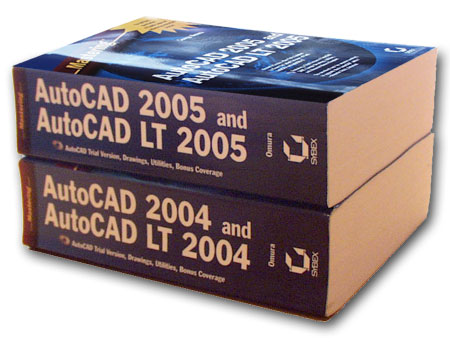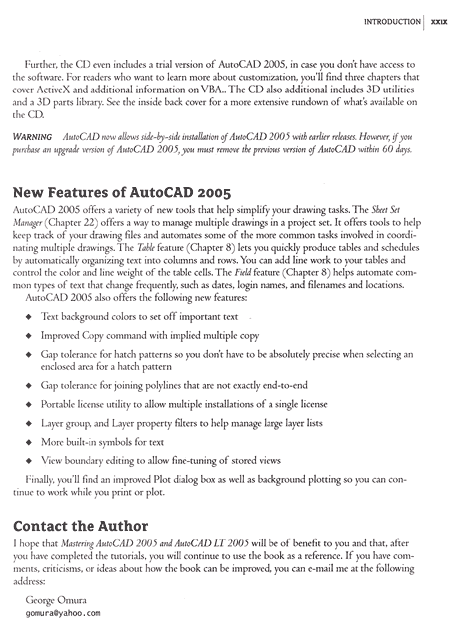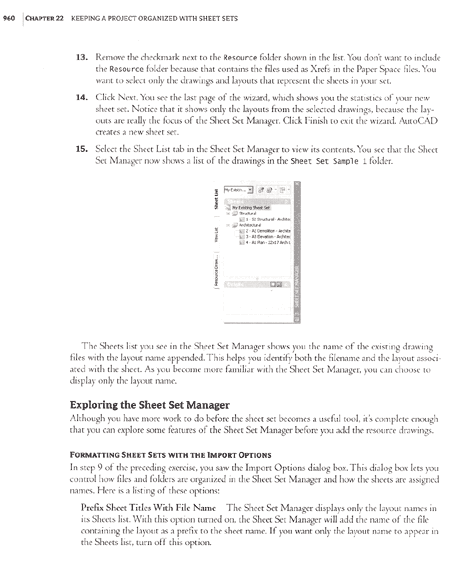Last year I wrote my first review of George Omura's Mastering™ AutoCAD book with the sense that all I was achieving was a statement of the obvious. Within the AutoCAD community I have yet to come across a seasoned user who doesn't know about his books and here in the San Francisco Bay Area I still encounter clients for whom George Omura cut his teeth as a consultant in the early years of AutoCAD.
George Omura has been writing about AutoCAD and related software for a long time now and as someone who has been working with this product since its first release, I have to say that it amazes me that he can continue updating his books year after year after year; and do it enthusiastically. But we are in a new era of software release cycles now that puts pressure on everyone to move faster. In fact, if you consider Autodesk's decision to release new versions of their software on an annual cycle that is basically two times as fast as in the past. How does an author keep up?
For this review I will focus on how well George Omura has managed to update his Mastering™ AutoCAD® 2005 and AutoCAD LT® 2005 from the previous 2004 edition I reviewed a year ago. To read my review of pick on this link: Mastering™ AutoCAD® 2004 and AutoCAD LT® 2004

Illustrated above I show how the physical proportions of Mastering™ AutoCAD® 2005 and AutoCAD LT® 2005 stack up against last year's book. Believe it or not, George Omura managed to do some cleanup, change graphics and add all of the new 2005 information in a book that is something like four pages shorter.
If you have already received your copy of AutoCAD 2005 or AutoCAD LT 2005 you are probably aware of many of the changes that have occurred since 2004 and if you skipped 2004 then you are really in for some surprises.
Illustrated to the right I show a page from George Omura's latest book where he outlines the "New Features of AutoCAD 2005" and provides Chapter listings of where you can go to read up on these improvements. If you already have a copy of the previous book, it's this type of listing that makes an upgrade in your book purchase worthwhile because that's basically all you are buying: information on the new features. If you are browsing in a bookstore take a look at the inside back cover for another list of new features covered in this book.
Though the list seems fairly short, as are the number of new features in AutoCAD 2005, they are pervasive (some are downright ponderous) so don't be fooled by the brevity of this list. The Sheet Set Manager, alone, will have you rethinking your entire project file structure and the Field tools that you can employ with this Manager will have you redesigning many of your documentation Blocks for hours if not months - see comments in the next cell below.
Instead of simply adding chapters or new pages at the end of existing chapters, you will find that somehow George Omura found the time to integrate new topics within the previous book so it doesn't read as an upgrade but rather a book written from scratch. You will find information on the new Table Object, for example, in Chapter 8 - "Adding Text to Drawings" ( same chapter heading as in 2004 ) along with great new options for other text related tools ( Tabs in the Mtext Editor, finally, and Masking ).
Scanned Page, Image Right:
reproduced by permission from Mastering™ AutoCAD® 2005 and AutoCAD LT® 2005
, © 2004 Sybex, Inc.

Illustrated to the right I show another page in George Omura's book where he discusses the Sheet Set Manager. No matter how experienced you may be about using and customizing AutoCAD, this new tool will take some effort and time to master. Having worked with the earlier incarnation in Architectural Desktop and continuing to work with the current version in ADT, called Project Navigator ( SSM on steroids, you might say), I can tell you that you are only seeing the beginning of what this tool can offer. In other words, just because you can continue working with AutoCAD as you may have done for years, don't neglect this tool. Chapter 22 - "Keeping a Project Organized with Sheet Sets" will be of significant value to those wanting to explore the use of the Sheet Set Manager.
Among the many other things you will learn about in this book are improvements to the Layer Manager (though it's slow as molasses), Hatching, Plotting (yep, they changed it again), Xref's (new path options, yippee), Background Color to Mask Dimensions and Mtext, Truly Static DrawOrder (it's about time) and a plethora of other things including a list of all system variables so you can tweak settings you never knew existed in AutoCAD.
George Omura has proven to me that he is "Mastering" the art of keeping up with Autodesk's latest release cycles and that's quite an accomplishment when you consider what it takes to learn on undocumented Beta Releases, update and correct for the final cut, have it all proofed and processed and out to print by Sybex within a year ( plus or minus ). At nearly 5lbs this book will add bulk to your brains as well as your arms.
Scanned Page, Image Right:
reproduced by permission from Mastering™ AutoCAD® 2005 and AutoCAD LT® 2005
, © 2004 Sybex, Inc.

George Omura
MasteringTM AutoCAD® 2005 and AutoCAD LT® 2005
www.sybex.com
SYBEX; ISBN: 0-7821-4340-7
Included with this book is a CD that has a 30-day trial version of AutoCAD 2005 plus numerous exercise files, example drawings, custom code and more writing that probably couldn't fit in the book.
Read a sample chapter: http://www.sybex.com/sybexbooks.nsf/AdditionalContent/4340Sample?OpenDocument
It should be noted that none of my sarcastic commentary is a reflection of the views expressed by George Omura, the people at SYBEX or Autodesk.